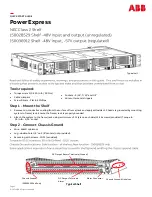
Example for time coordination
Assume two substations A and B directly connected to each other via one line, as
shown in the Figure
. Consider a fault located at another line from the station B. The
fault current to the overcurrent protection of IED B1 has a magnitude so that the
overcurrent protection will start and subsequently trip, and the overcurrent protection
of IED A1 must have a delayed operation in order to avoid maloperation. The sequence
of events during the fault can be described using a time axis shown in Figure
A1
B1
Feeder
Time axis
t=0
t=t
1
t=t
2
t=t
3
The fault
occurs
Protection
B1 trips
Breaker at
B1 opens
Protection
A1 resets
en05000205_ansi.vsd
51
51
ANSI05000205 V1 EN-US
Figure 91:
Sequence of events during fault
where:
t=0
is when the fault occurs
t=t
1
is when protection IED B1 and protection IED A1 start
t=t
2
is when the trip signal from the overcurrent protection at IED B1 is sent to the circuit breaker.
t=t
3
is when the circuit breaker at IED B1 opens. The circuit breaker opening time is t
3
- t
2
t=t
4
is when the overcurrent protection at IED A1 resets. The protection resetting time is t
4
- t
3
.
To ensure that the overcurrent protection at IED A1 is selective to the overcurrent
protection at IED B1, the minimum time difference must be larger than the time t
3
.
There are uncertainties in the values of protection operation time, breaker opening time
and protection resetting time. Therefore a safety margin has to be included. With
normal values the needed time difference can be calculated according to Equation
Section 7
1MRK 505 370-UUS A
Current protection
186
Busbar protection REB670 2.2 ANSI
Application manual
Summary of Contents for RELION REB670
Page 1: ...RELION 670 SERIES Busbar protection REB670 Version 2 2 ANSI Application manual ...
Page 2: ......
Page 24: ...18 ...
Page 40: ...34 ...
Page 72: ...66 ...
Page 102: ...96 ...
Page 266: ...260 ...
Page 272: ...266 ...
Page 290: ...284 ...
Page 432: ...426 ...
Page 542: ...536 ...
Page 552: ...546 ...
Page 553: ...547 ...
















































